Case Study: Nursing Management of Measles in a 12-Year-Old Patient
VerifiedAdded on 2022/11/10
|10
|2880
|1
Case Study
AI Summary
This case study presents a nursing analysis of a 12-year-old patient, Caroline, diagnosed with measles. The assignment begins with a detailed description of the disease, including its etiology (ssRNA paramyxovirus) and clinical manifestations such as Koplik's spots, fever, rash, and potential complications like encephalitis. It then identifies risk factors within the family and community, emphasizing the importance of MMR vaccination. The core of the assignment focuses on nursing interventions, assessment strategies (measuring body temperature, assessing vital signs, and providing skin and eye care), and nursing priorities, including isolation, parent and child education, and informed consent. The case study highlights the importance of monitoring the patient's condition, preventing the spread of infection, and providing supportive care to alleviate symptoms and promote recovery. The nursing responsibilities include administering MMR vaccination, isolating the patient, providing skin and eye care, educating parents, and ensuring patient confidentiality.
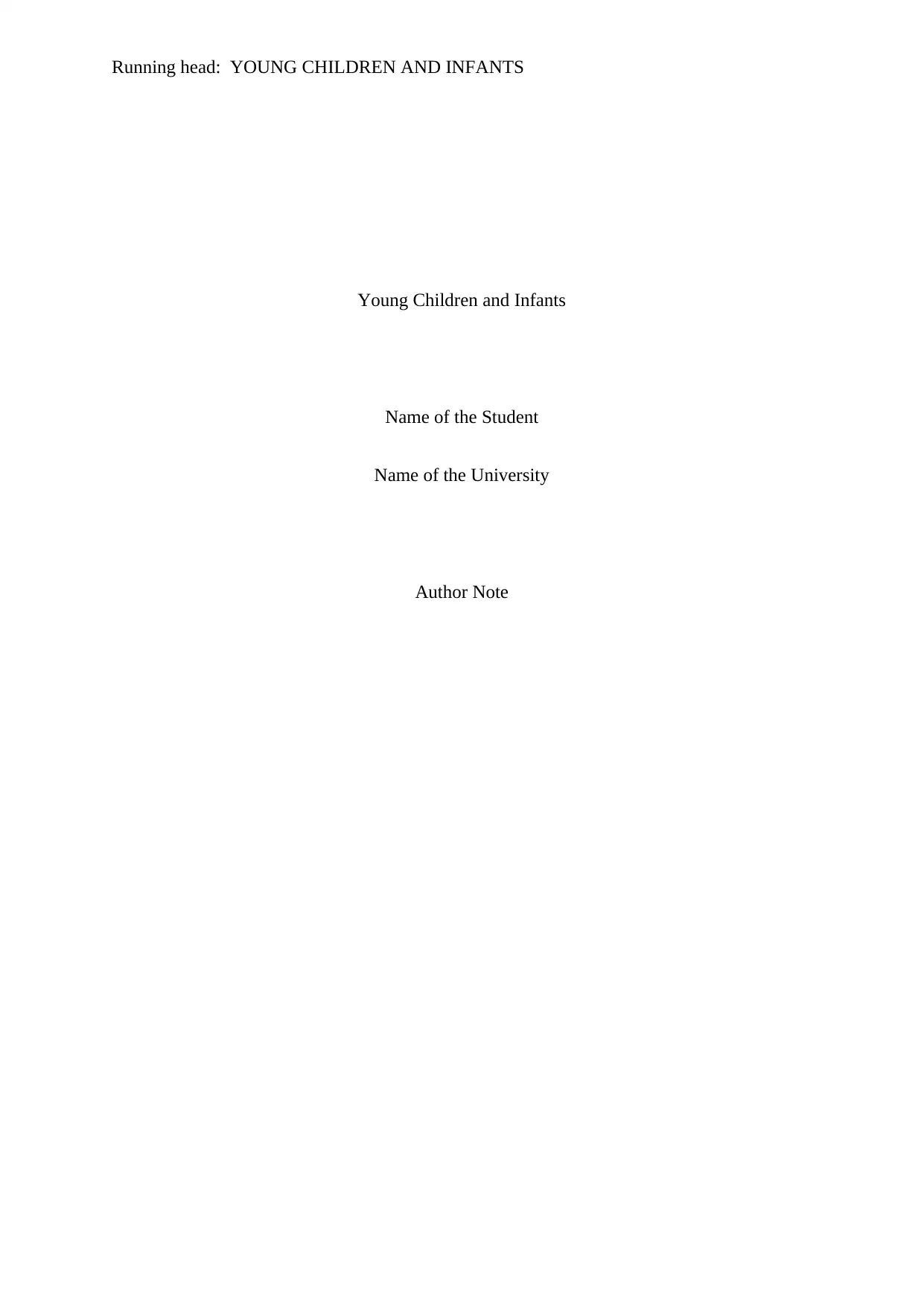
Running head: YOUNG CHILDREN AND INFANTS
Young Children and Infants
Name of the Student
Name of the University
Author Note
Young Children and Infants
Name of the Student
Name of the University
Author Note
Paraphrase This Document
Need a fresh take? Get an instant paraphrase of this document with our AI Paraphraser
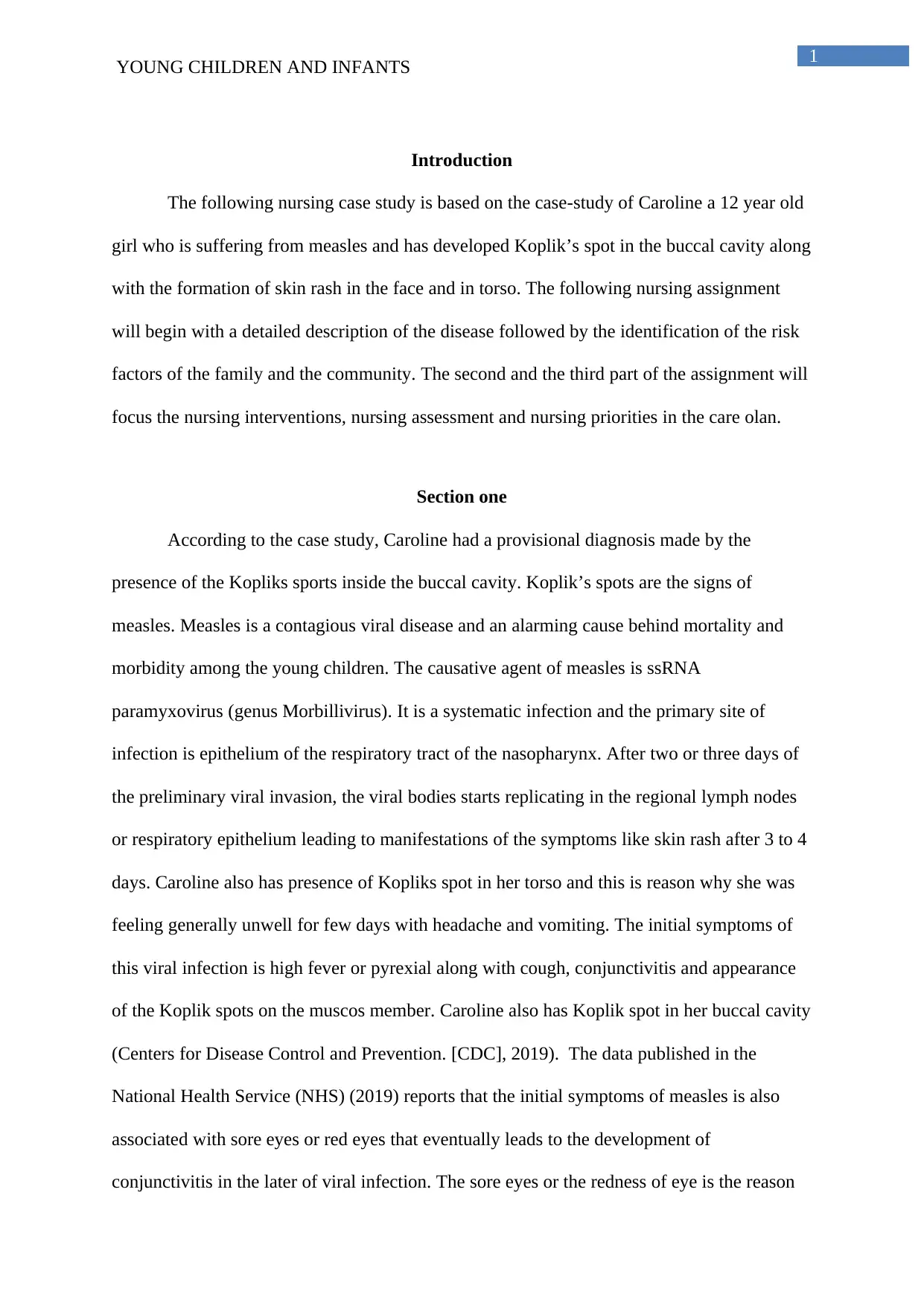
1
YOUNG CHILDREN AND INFANTS
Introduction
The following nursing case study is based on the case-study of Caroline a 12 year old
girl who is suffering from measles and has developed Koplik’s spot in the buccal cavity along
with the formation of skin rash in the face and in torso. The following nursing assignment
will begin with a detailed description of the disease followed by the identification of the risk
factors of the family and the community. The second and the third part of the assignment will
focus the nursing interventions, nursing assessment and nursing priorities in the care olan.
Section one
According to the case study, Caroline had a provisional diagnosis made by the
presence of the Kopliks sports inside the buccal cavity. Koplik’s spots are the signs of
measles. Measles is a contagious viral disease and an alarming cause behind mortality and
morbidity among the young children. The causative agent of measles is ssRNA
paramyxovirus (genus Morbillivirus). It is a systematic infection and the primary site of
infection is epithelium of the respiratory tract of the nasopharynx. After two or three days of
the preliminary viral invasion, the viral bodies starts replicating in the regional lymph nodes
or respiratory epithelium leading to manifestations of the symptoms like skin rash after 3 to 4
days. Caroline also has presence of Kopliks spot in her torso and this is reason why she was
feeling generally unwell for few days with headache and vomiting. The initial symptoms of
this viral infection is high fever or pyrexial along with cough, conjunctivitis and appearance
of the Koplik spots on the muscos member. Caroline also has Koplik spot in her buccal cavity
(Centers for Disease Control and Prevention. [CDC], 2019). The data published in the
National Health Service (NHS) (2019) reports that the initial symptoms of measles is also
associated with sore eyes or red eyes that eventually leads to the development of
conjunctivitis in the later of viral infection. The sore eyes or the redness of eye is the reason
YOUNG CHILDREN AND INFANTS
Introduction
The following nursing case study is based on the case-study of Caroline a 12 year old
girl who is suffering from measles and has developed Koplik’s spot in the buccal cavity along
with the formation of skin rash in the face and in torso. The following nursing assignment
will begin with a detailed description of the disease followed by the identification of the risk
factors of the family and the community. The second and the third part of the assignment will
focus the nursing interventions, nursing assessment and nursing priorities in the care olan.
Section one
According to the case study, Caroline had a provisional diagnosis made by the
presence of the Kopliks sports inside the buccal cavity. Koplik’s spots are the signs of
measles. Measles is a contagious viral disease and an alarming cause behind mortality and
morbidity among the young children. The causative agent of measles is ssRNA
paramyxovirus (genus Morbillivirus). It is a systematic infection and the primary site of
infection is epithelium of the respiratory tract of the nasopharynx. After two or three days of
the preliminary viral invasion, the viral bodies starts replicating in the regional lymph nodes
or respiratory epithelium leading to manifestations of the symptoms like skin rash after 3 to 4
days. Caroline also has presence of Kopliks spot in her torso and this is reason why she was
feeling generally unwell for few days with headache and vomiting. The initial symptoms of
this viral infection is high fever or pyrexial along with cough, conjunctivitis and appearance
of the Koplik spots on the muscos member. Caroline also has Koplik spot in her buccal cavity
(Centers for Disease Control and Prevention. [CDC], 2019). The data published in the
National Health Service (NHS) (2019) reports that the initial symptoms of measles is also
associated with sore eyes or red eyes that eventually leads to the development of
conjunctivitis in the later of viral infection. The sore eyes or the redness of eye is the reason
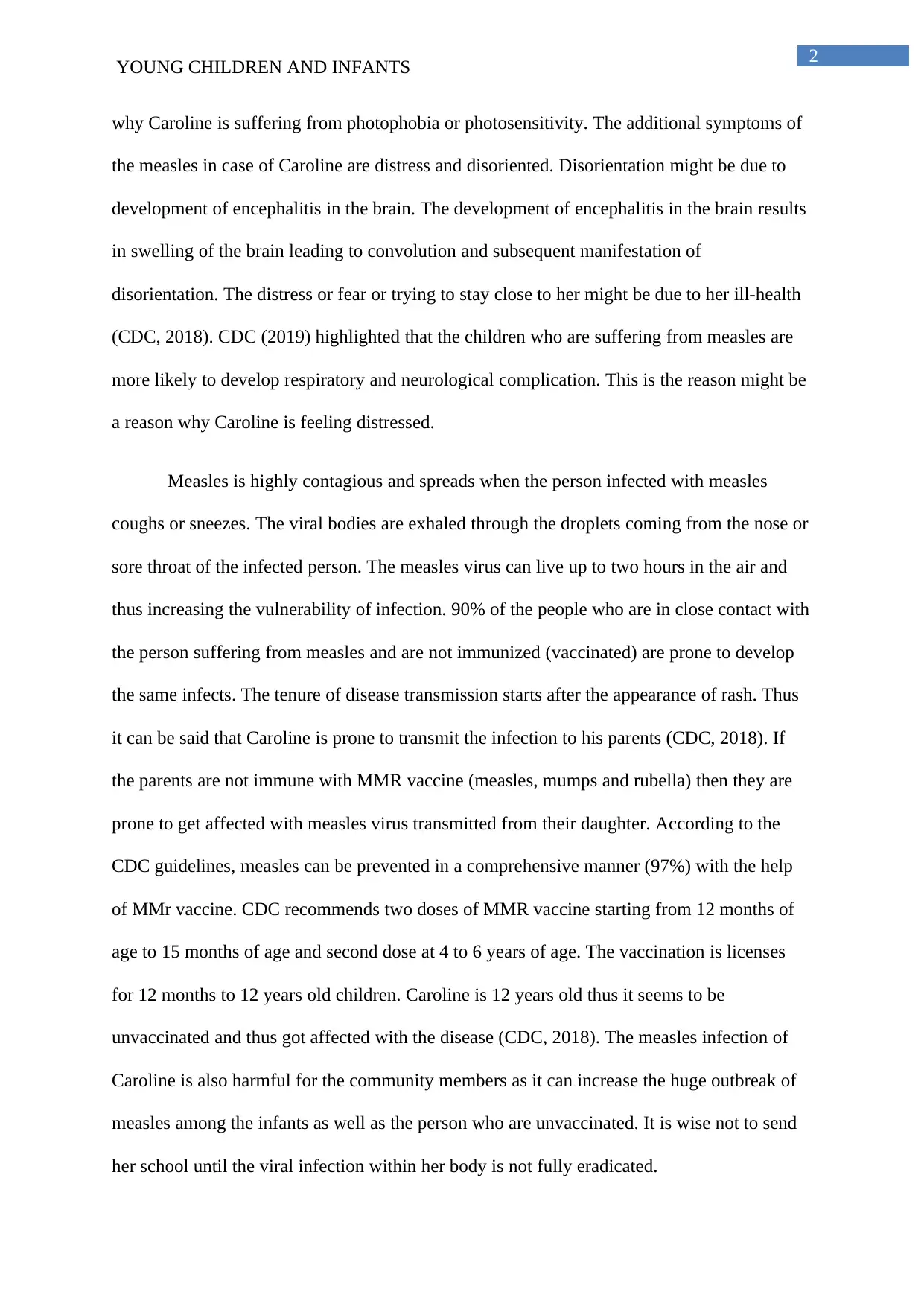
2
YOUNG CHILDREN AND INFANTS
why Caroline is suffering from photophobia or photosensitivity. The additional symptoms of
the measles in case of Caroline are distress and disoriented. Disorientation might be due to
development of encephalitis in the brain. The development of encephalitis in the brain results
in swelling of the brain leading to convolution and subsequent manifestation of
disorientation. The distress or fear or trying to stay close to her might be due to her ill-health
(CDC, 2018). CDC (2019) highlighted that the children who are suffering from measles are
more likely to develop respiratory and neurological complication. This is the reason might be
a reason why Caroline is feeling distressed.
Measles is highly contagious and spreads when the person infected with measles
coughs or sneezes. The viral bodies are exhaled through the droplets coming from the nose or
sore throat of the infected person. The measles virus can live up to two hours in the air and
thus increasing the vulnerability of infection. 90% of the people who are in close contact with
the person suffering from measles and are not immunized (vaccinated) are prone to develop
the same infects. The tenure of disease transmission starts after the appearance of rash. Thus
it can be said that Caroline is prone to transmit the infection to his parents (CDC, 2018). If
the parents are not immune with MMR vaccine (measles, mumps and rubella) then they are
prone to get affected with measles virus transmitted from their daughter. According to the
CDC guidelines, measles can be prevented in a comprehensive manner (97%) with the help
of MMr vaccine. CDC recommends two doses of MMR vaccine starting from 12 months of
age to 15 months of age and second dose at 4 to 6 years of age. The vaccination is licenses
for 12 months to 12 years old children. Caroline is 12 years old thus it seems to be
unvaccinated and thus got affected with the disease (CDC, 2018). The measles infection of
Caroline is also harmful for the community members as it can increase the huge outbreak of
measles among the infants as well as the person who are unvaccinated. It is wise not to send
her school until the viral infection within her body is not fully eradicated.
YOUNG CHILDREN AND INFANTS
why Caroline is suffering from photophobia or photosensitivity. The additional symptoms of
the measles in case of Caroline are distress and disoriented. Disorientation might be due to
development of encephalitis in the brain. The development of encephalitis in the brain results
in swelling of the brain leading to convolution and subsequent manifestation of
disorientation. The distress or fear or trying to stay close to her might be due to her ill-health
(CDC, 2018). CDC (2019) highlighted that the children who are suffering from measles are
more likely to develop respiratory and neurological complication. This is the reason might be
a reason why Caroline is feeling distressed.
Measles is highly contagious and spreads when the person infected with measles
coughs or sneezes. The viral bodies are exhaled through the droplets coming from the nose or
sore throat of the infected person. The measles virus can live up to two hours in the air and
thus increasing the vulnerability of infection. 90% of the people who are in close contact with
the person suffering from measles and are not immunized (vaccinated) are prone to develop
the same infects. The tenure of disease transmission starts after the appearance of rash. Thus
it can be said that Caroline is prone to transmit the infection to his parents (CDC, 2018). If
the parents are not immune with MMR vaccine (measles, mumps and rubella) then they are
prone to get affected with measles virus transmitted from their daughter. According to the
CDC guidelines, measles can be prevented in a comprehensive manner (97%) with the help
of MMr vaccine. CDC recommends two doses of MMR vaccine starting from 12 months of
age to 15 months of age and second dose at 4 to 6 years of age. The vaccination is licenses
for 12 months to 12 years old children. Caroline is 12 years old thus it seems to be
unvaccinated and thus got affected with the disease (CDC, 2018). The measles infection of
Caroline is also harmful for the community members as it can increase the huge outbreak of
measles among the infants as well as the person who are unvaccinated. It is wise not to send
her school until the viral infection within her body is not fully eradicated.
⊘ This is a preview!⊘
Do you want full access?
Subscribe today to unlock all pages.

Trusted by 1+ million students worldwide
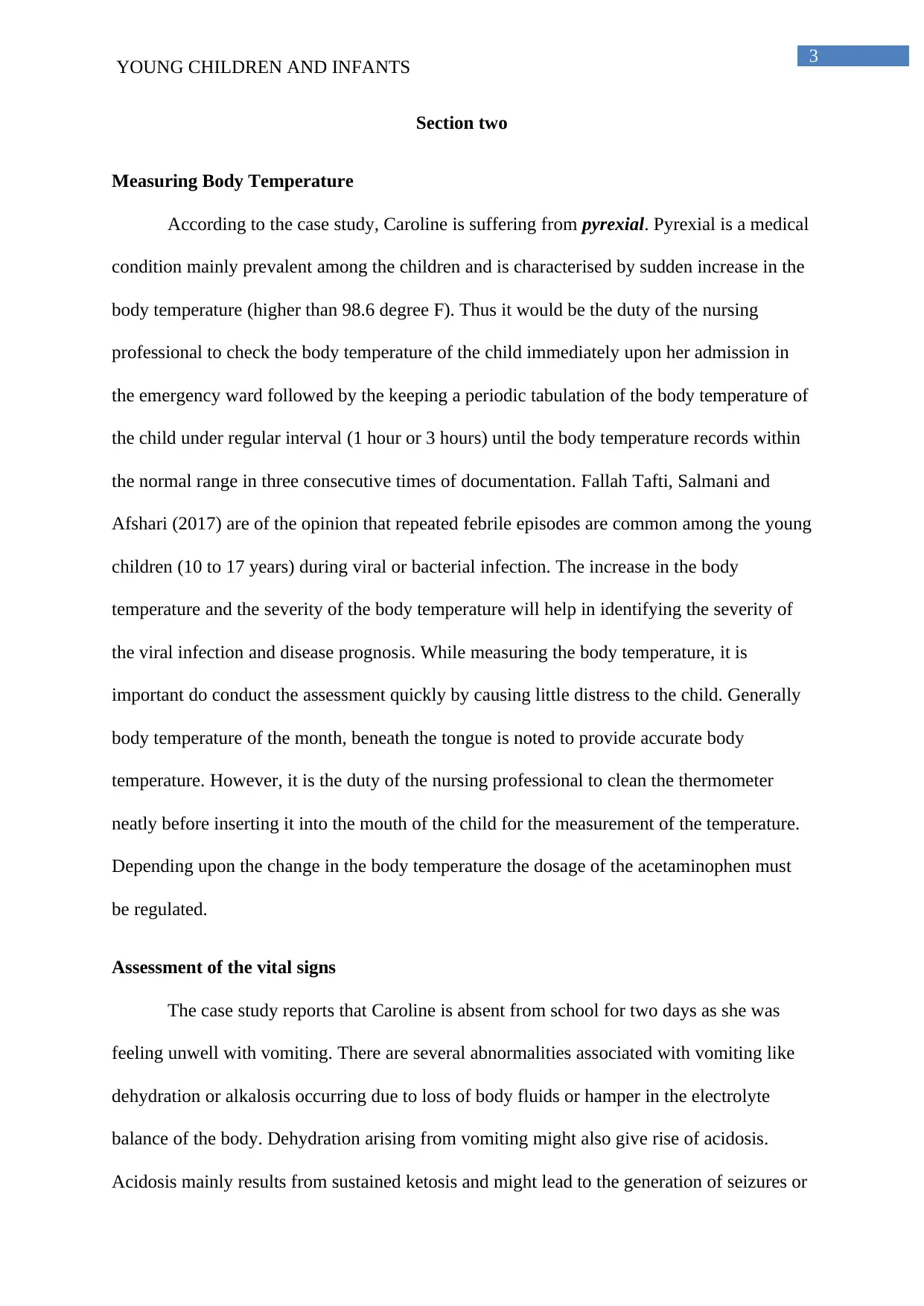
3
YOUNG CHILDREN AND INFANTS
Section two
Measuring Body Temperature
According to the case study, Caroline is suffering from pyrexial. Pyrexial is a medical
condition mainly prevalent among the children and is characterised by sudden increase in the
body temperature (higher than 98.6 degree F). Thus it would be the duty of the nursing
professional to check the body temperature of the child immediately upon her admission in
the emergency ward followed by the keeping a periodic tabulation of the body temperature of
the child under regular interval (1 hour or 3 hours) until the body temperature records within
the normal range in three consecutive times of documentation. Fallah Tafti, Salmani and
Afshari (2017) are of the opinion that repeated febrile episodes are common among the young
children (10 to 17 years) during viral or bacterial infection. The increase in the body
temperature and the severity of the body temperature will help in identifying the severity of
the viral infection and disease prognosis. While measuring the body temperature, it is
important do conduct the assessment quickly by causing little distress to the child. Generally
body temperature of the month, beneath the tongue is noted to provide accurate body
temperature. However, it is the duty of the nursing professional to clean the thermometer
neatly before inserting it into the mouth of the child for the measurement of the temperature.
Depending upon the change in the body temperature the dosage of the acetaminophen must
be regulated.
Assessment of the vital signs
The case study reports that Caroline is absent from school for two days as she was
feeling unwell with vomiting. There are several abnormalities associated with vomiting like
dehydration or alkalosis occurring due to loss of body fluids or hamper in the electrolyte
balance of the body. Dehydration arising from vomiting might also give rise of acidosis.
Acidosis mainly results from sustained ketosis and might lead to the generation of seizures or
YOUNG CHILDREN AND INFANTS
Section two
Measuring Body Temperature
According to the case study, Caroline is suffering from pyrexial. Pyrexial is a medical
condition mainly prevalent among the children and is characterised by sudden increase in the
body temperature (higher than 98.6 degree F). Thus it would be the duty of the nursing
professional to check the body temperature of the child immediately upon her admission in
the emergency ward followed by the keeping a periodic tabulation of the body temperature of
the child under regular interval (1 hour or 3 hours) until the body temperature records within
the normal range in three consecutive times of documentation. Fallah Tafti, Salmani and
Afshari (2017) are of the opinion that repeated febrile episodes are common among the young
children (10 to 17 years) during viral or bacterial infection. The increase in the body
temperature and the severity of the body temperature will help in identifying the severity of
the viral infection and disease prognosis. While measuring the body temperature, it is
important do conduct the assessment quickly by causing little distress to the child. Generally
body temperature of the month, beneath the tongue is noted to provide accurate body
temperature. However, it is the duty of the nursing professional to clean the thermometer
neatly before inserting it into the mouth of the child for the measurement of the temperature.
Depending upon the change in the body temperature the dosage of the acetaminophen must
be regulated.
Assessment of the vital signs
The case study reports that Caroline is absent from school for two days as she was
feeling unwell with vomiting. There are several abnormalities associated with vomiting like
dehydration or alkalosis occurring due to loss of body fluids or hamper in the electrolyte
balance of the body. Dehydration arising from vomiting might also give rise of acidosis.
Acidosis mainly results from sustained ketosis and might lead to the generation of seizures or
Paraphrase This Document
Need a fresh take? Get an instant paraphrase of this document with our AI Paraphraser
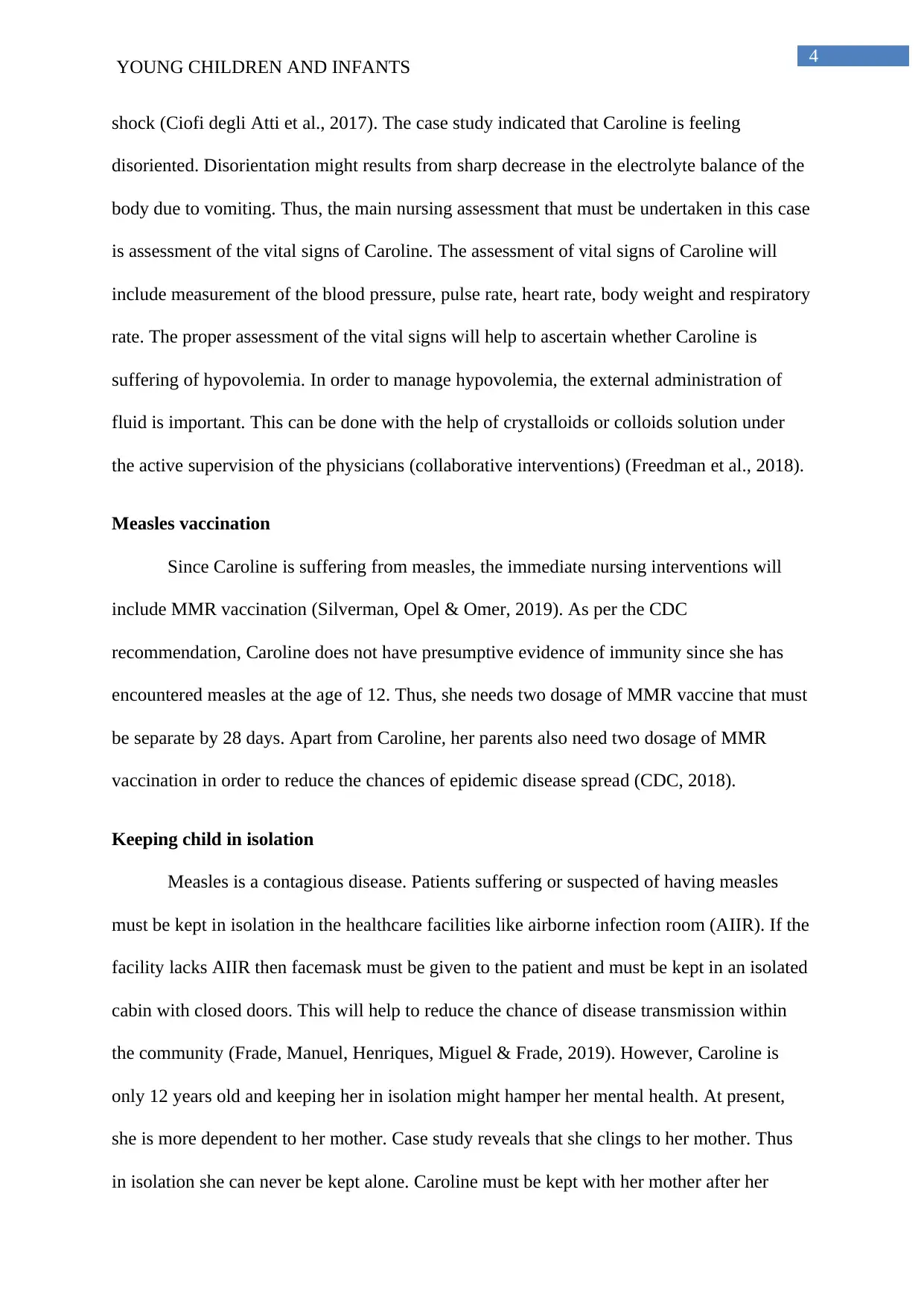
4
YOUNG CHILDREN AND INFANTS
shock (Ciofi degli Atti et al., 2017). The case study indicated that Caroline is feeling
disoriented. Disorientation might results from sharp decrease in the electrolyte balance of the
body due to vomiting. Thus, the main nursing assessment that must be undertaken in this case
is assessment of the vital signs of Caroline. The assessment of vital signs of Caroline will
include measurement of the blood pressure, pulse rate, heart rate, body weight and respiratory
rate. The proper assessment of the vital signs will help to ascertain whether Caroline is
suffering of hypovolemia. In order to manage hypovolemia, the external administration of
fluid is important. This can be done with the help of crystalloids or colloids solution under
the active supervision of the physicians (collaborative interventions) (Freedman et al., 2018).
Measles vaccination
Since Caroline is suffering from measles, the immediate nursing interventions will
include MMR vaccination (Silverman, Opel & Omer, 2019). As per the CDC
recommendation, Caroline does not have presumptive evidence of immunity since she has
encountered measles at the age of 12. Thus, she needs two dosage of MMR vaccine that must
be separate by 28 days. Apart from Caroline, her parents also need two dosage of MMR
vaccination in order to reduce the chances of epidemic disease spread (CDC, 2018).
Keeping child in isolation
Measles is a contagious disease. Patients suffering or suspected of having measles
must be kept in isolation in the healthcare facilities like airborne infection room (AIIR). If the
facility lacks AIIR then facemask must be given to the patient and must be kept in an isolated
cabin with closed doors. This will help to reduce the chance of disease transmission within
the community (Frade, Manuel, Henriques, Miguel & Frade, 2019). However, Caroline is
only 12 years old and keeping her in isolation might hamper her mental health. At present,
she is more dependent to her mother. Case study reveals that she clings to her mother. Thus
in isolation she can never be kept alone. Caroline must be kept with her mother after her
YOUNG CHILDREN AND INFANTS
shock (Ciofi degli Atti et al., 2017). The case study indicated that Caroline is feeling
disoriented. Disorientation might results from sharp decrease in the electrolyte balance of the
body due to vomiting. Thus, the main nursing assessment that must be undertaken in this case
is assessment of the vital signs of Caroline. The assessment of vital signs of Caroline will
include measurement of the blood pressure, pulse rate, heart rate, body weight and respiratory
rate. The proper assessment of the vital signs will help to ascertain whether Caroline is
suffering of hypovolemia. In order to manage hypovolemia, the external administration of
fluid is important. This can be done with the help of crystalloids or colloids solution under
the active supervision of the physicians (collaborative interventions) (Freedman et al., 2018).
Measles vaccination
Since Caroline is suffering from measles, the immediate nursing interventions will
include MMR vaccination (Silverman, Opel & Omer, 2019). As per the CDC
recommendation, Caroline does not have presumptive evidence of immunity since she has
encountered measles at the age of 12. Thus, she needs two dosage of MMR vaccine that must
be separate by 28 days. Apart from Caroline, her parents also need two dosage of MMR
vaccination in order to reduce the chances of epidemic disease spread (CDC, 2018).
Keeping child in isolation
Measles is a contagious disease. Patients suffering or suspected of having measles
must be kept in isolation in the healthcare facilities like airborne infection room (AIIR). If the
facility lacks AIIR then facemask must be given to the patient and must be kept in an isolated
cabin with closed doors. This will help to reduce the chance of disease transmission within
the community (Frade, Manuel, Henriques, Miguel & Frade, 2019). However, Caroline is
only 12 years old and keeping her in isolation might hamper her mental health. At present,
she is more dependent to her mother. Case study reveals that she clings to her mother. Thus
in isolation she can never be kept alone. Caroline must be kept with her mother after her
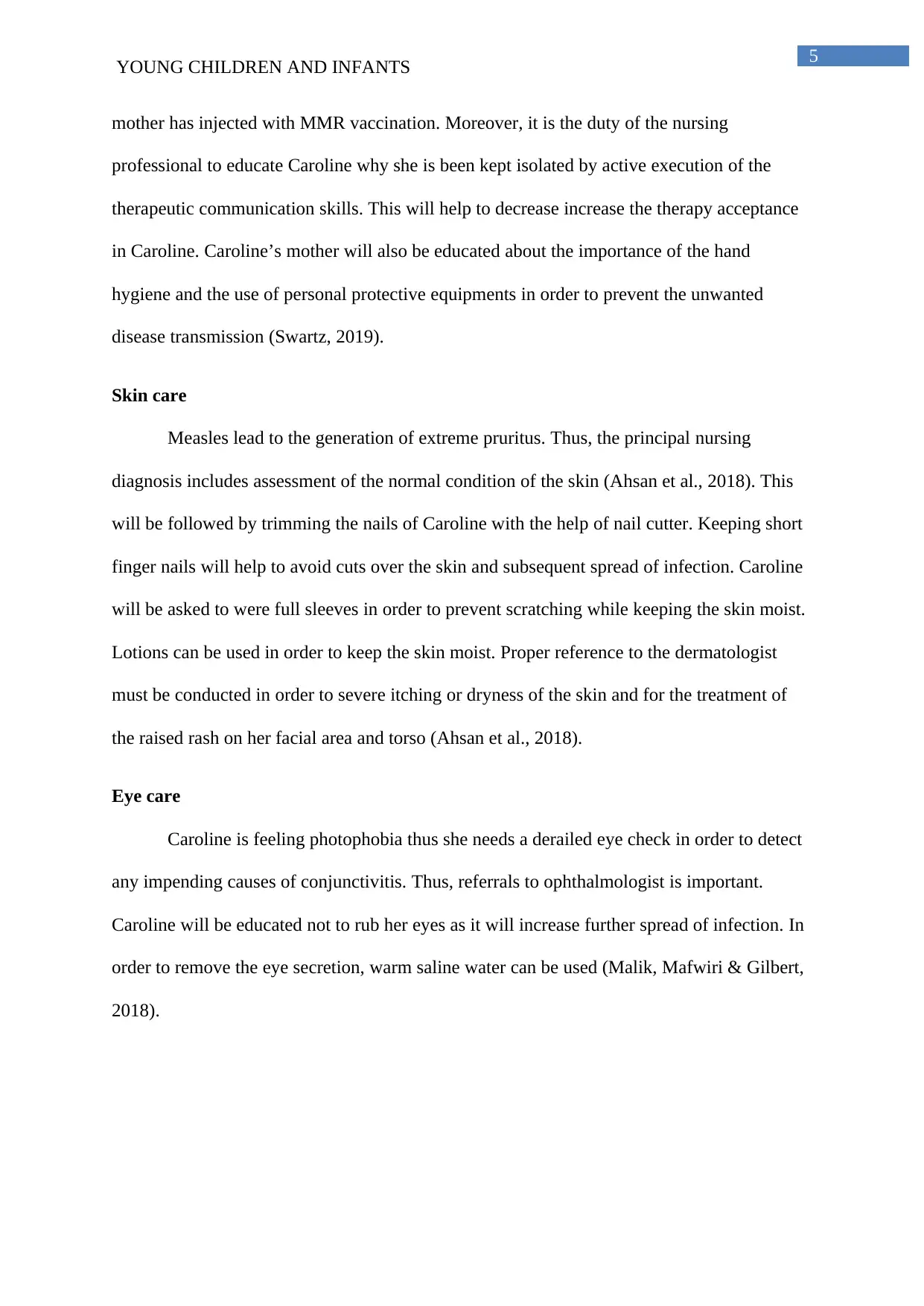
5
YOUNG CHILDREN AND INFANTS
mother has injected with MMR vaccination. Moreover, it is the duty of the nursing
professional to educate Caroline why she is been kept isolated by active execution of the
therapeutic communication skills. This will help to decrease increase the therapy acceptance
in Caroline. Caroline’s mother will also be educated about the importance of the hand
hygiene and the use of personal protective equipments in order to prevent the unwanted
disease transmission (Swartz, 2019).
Skin care
Measles lead to the generation of extreme pruritus. Thus, the principal nursing
diagnosis includes assessment of the normal condition of the skin (Ahsan et al., 2018). This
will be followed by trimming the nails of Caroline with the help of nail cutter. Keeping short
finger nails will help to avoid cuts over the skin and subsequent spread of infection. Caroline
will be asked to were full sleeves in order to prevent scratching while keeping the skin moist.
Lotions can be used in order to keep the skin moist. Proper reference to the dermatologist
must be conducted in order to severe itching or dryness of the skin and for the treatment of
the raised rash on her facial area and torso (Ahsan et al., 2018).
Eye care
Caroline is feeling photophobia thus she needs a derailed eye check in order to detect
any impending causes of conjunctivitis. Thus, referrals to ophthalmologist is important.
Caroline will be educated not to rub her eyes as it will increase further spread of infection. In
order to remove the eye secretion, warm saline water can be used (Malik, Mafwiri & Gilbert,
2018).
YOUNG CHILDREN AND INFANTS
mother has injected with MMR vaccination. Moreover, it is the duty of the nursing
professional to educate Caroline why she is been kept isolated by active execution of the
therapeutic communication skills. This will help to decrease increase the therapy acceptance
in Caroline. Caroline’s mother will also be educated about the importance of the hand
hygiene and the use of personal protective equipments in order to prevent the unwanted
disease transmission (Swartz, 2019).
Skin care
Measles lead to the generation of extreme pruritus. Thus, the principal nursing
diagnosis includes assessment of the normal condition of the skin (Ahsan et al., 2018). This
will be followed by trimming the nails of Caroline with the help of nail cutter. Keeping short
finger nails will help to avoid cuts over the skin and subsequent spread of infection. Caroline
will be asked to were full sleeves in order to prevent scratching while keeping the skin moist.
Lotions can be used in order to keep the skin moist. Proper reference to the dermatologist
must be conducted in order to severe itching or dryness of the skin and for the treatment of
the raised rash on her facial area and torso (Ahsan et al., 2018).
Eye care
Caroline is feeling photophobia thus she needs a derailed eye check in order to detect
any impending causes of conjunctivitis. Thus, referrals to ophthalmologist is important.
Caroline will be educated not to rub her eyes as it will increase further spread of infection. In
order to remove the eye secretion, warm saline water can be used (Malik, Mafwiri & Gilbert,
2018).
⊘ This is a preview!⊘
Do you want full access?
Subscribe today to unlock all pages.

Trusted by 1+ million students worldwide
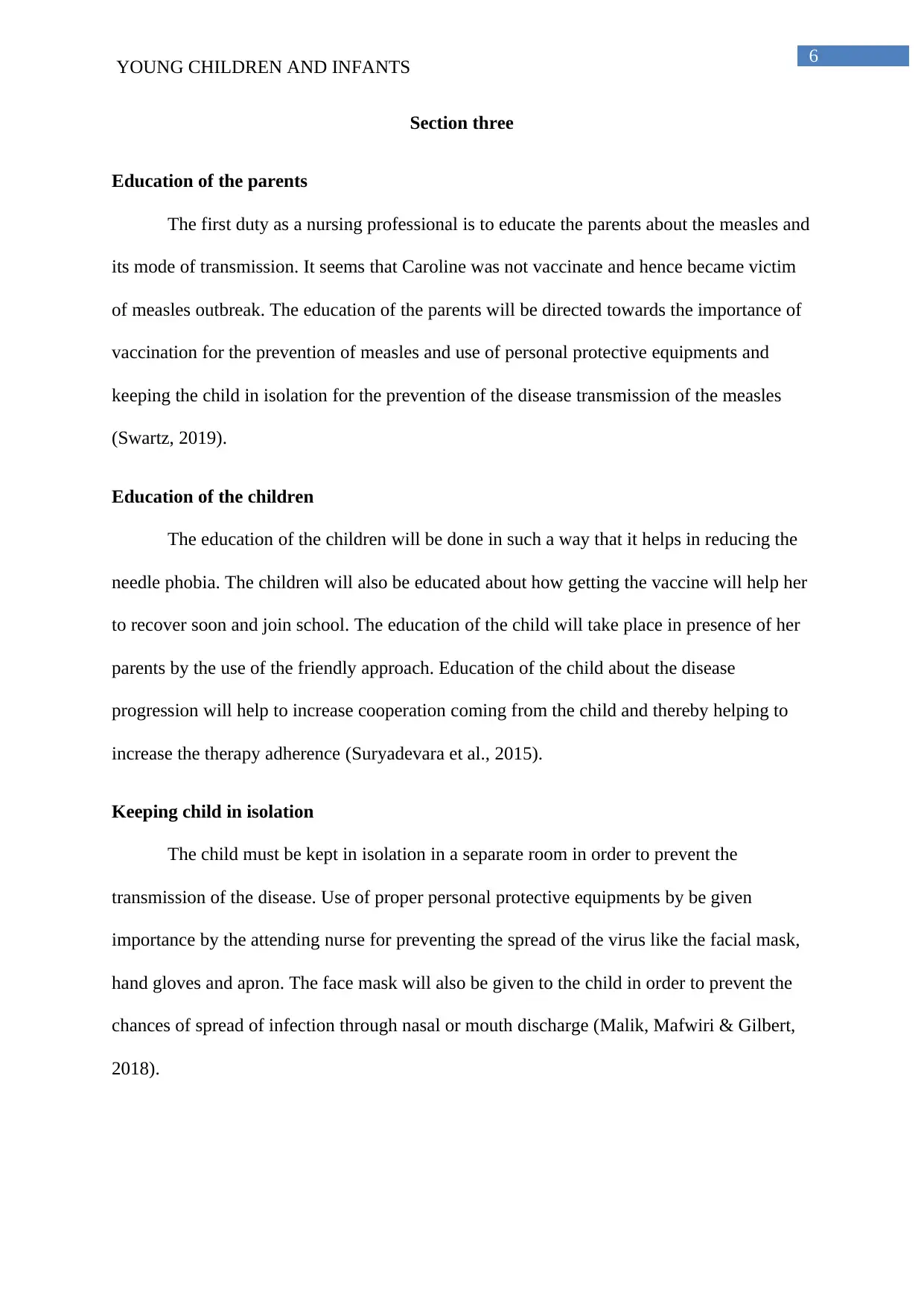
6
YOUNG CHILDREN AND INFANTS
Section three
Education of the parents
The first duty as a nursing professional is to educate the parents about the measles and
its mode of transmission. It seems that Caroline was not vaccinate and hence became victim
of measles outbreak. The education of the parents will be directed towards the importance of
vaccination for the prevention of measles and use of personal protective equipments and
keeping the child in isolation for the prevention of the disease transmission of the measles
(Swartz, 2019).
Education of the children
The education of the children will be done in such a way that it helps in reducing the
needle phobia. The children will also be educated about how getting the vaccine will help her
to recover soon and join school. The education of the child will take place in presence of her
parents by the use of the friendly approach. Education of the child about the disease
progression will help to increase cooperation coming from the child and thereby helping to
increase the therapy adherence (Suryadevara et al., 2015).
Keeping child in isolation
The child must be kept in isolation in a separate room in order to prevent the
transmission of the disease. Use of proper personal protective equipments by be given
importance by the attending nurse for preventing the spread of the virus like the facial mask,
hand gloves and apron. The face mask will also be given to the child in order to prevent the
chances of spread of infection through nasal or mouth discharge (Malik, Mafwiri & Gilbert,
2018).
YOUNG CHILDREN AND INFANTS
Section three
Education of the parents
The first duty as a nursing professional is to educate the parents about the measles and
its mode of transmission. It seems that Caroline was not vaccinate and hence became victim
of measles outbreak. The education of the parents will be directed towards the importance of
vaccination for the prevention of measles and use of personal protective equipments and
keeping the child in isolation for the prevention of the disease transmission of the measles
(Swartz, 2019).
Education of the children
The education of the children will be done in such a way that it helps in reducing the
needle phobia. The children will also be educated about how getting the vaccine will help her
to recover soon and join school. The education of the child will take place in presence of her
parents by the use of the friendly approach. Education of the child about the disease
progression will help to increase cooperation coming from the child and thereby helping to
increase the therapy adherence (Suryadevara et al., 2015).
Keeping child in isolation
The child must be kept in isolation in a separate room in order to prevent the
transmission of the disease. Use of proper personal protective equipments by be given
importance by the attending nurse for preventing the spread of the virus like the facial mask,
hand gloves and apron. The face mask will also be given to the child in order to prevent the
chances of spread of infection through nasal or mouth discharge (Malik, Mafwiri & Gilbert,
2018).
Paraphrase This Document
Need a fresh take? Get an instant paraphrase of this document with our AI Paraphraser
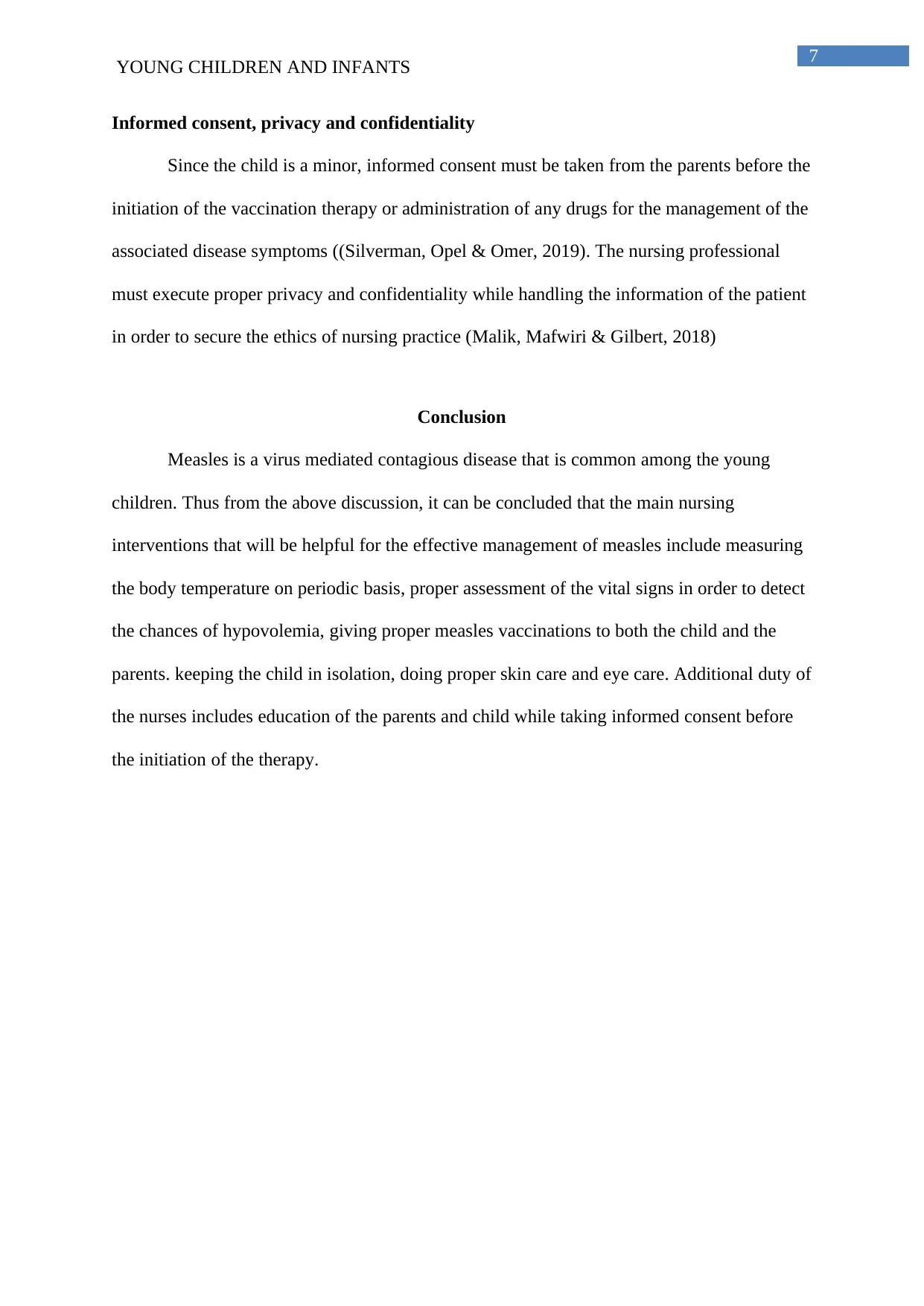
7
YOUNG CHILDREN AND INFANTS
Informed consent, privacy and confidentiality
Since the child is a minor, informed consent must be taken from the parents before the
initiation of the vaccination therapy or administration of any drugs for the management of the
associated disease symptoms ((Silverman, Opel & Omer, 2019). The nursing professional
must execute proper privacy and confidentiality while handling the information of the patient
in order to secure the ethics of nursing practice (Malik, Mafwiri & Gilbert, 2018)
Conclusion
Measles is a virus mediated contagious disease that is common among the young
children. Thus from the above discussion, it can be concluded that the main nursing
interventions that will be helpful for the effective management of measles include measuring
the body temperature on periodic basis, proper assessment of the vital signs in order to detect
the chances of hypovolemia, giving proper measles vaccinations to both the child and the
parents. keeping the child in isolation, doing proper skin care and eye care. Additional duty of
the nurses includes education of the parents and child while taking informed consent before
the initiation of the therapy.
YOUNG CHILDREN AND INFANTS
Informed consent, privacy and confidentiality
Since the child is a minor, informed consent must be taken from the parents before the
initiation of the vaccination therapy or administration of any drugs for the management of the
associated disease symptoms ((Silverman, Opel & Omer, 2019). The nursing professional
must execute proper privacy and confidentiality while handling the information of the patient
in order to secure the ethics of nursing practice (Malik, Mafwiri & Gilbert, 2018)
Conclusion
Measles is a virus mediated contagious disease that is common among the young
children. Thus from the above discussion, it can be concluded that the main nursing
interventions that will be helpful for the effective management of measles include measuring
the body temperature on periodic basis, proper assessment of the vital signs in order to detect
the chances of hypovolemia, giving proper measles vaccinations to both the child and the
parents. keeping the child in isolation, doing proper skin care and eye care. Additional duty of
the nurses includes education of the parents and child while taking informed consent before
the initiation of the therapy.
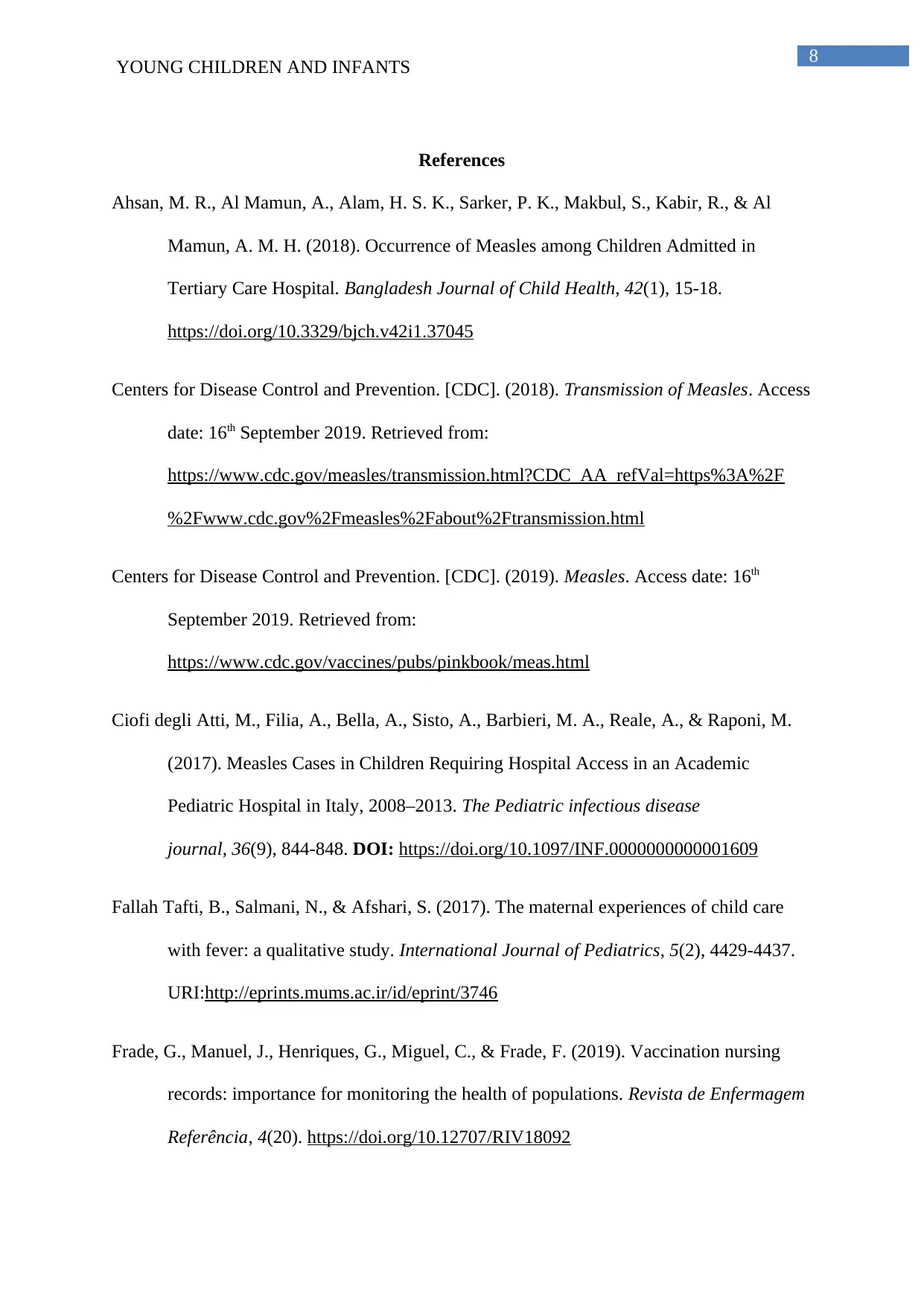
8
YOUNG CHILDREN AND INFANTS
References
Ahsan, M. R., Al Mamun, A., Alam, H. S. K., Sarker, P. K., Makbul, S., Kabir, R., & Al
Mamun, A. M. H. (2018). Occurrence of Measles among Children Admitted in
Tertiary Care Hospital. Bangladesh Journal of Child Health, 42(1), 15-18.
https://doi.org/10.3329/bjch.v42i1.37045
Centers for Disease Control and Prevention. [CDC]. (2018). Transmission of Measles. Access
date: 16th September 2019. Retrieved from:
https://www.cdc.gov/measles/transmission.html?CDC_AA_refVal=https%3A%2F
%2Fwww.cdc.gov%2Fmeasles%2Fabout%2Ftransmission.html
Centers for Disease Control and Prevention. [CDC]. (2019). Measles. Access date: 16th
September 2019. Retrieved from:
https://www.cdc.gov/vaccines/pubs/pinkbook/meas.html
Ciofi degli Atti, M., Filia, A., Bella, A., Sisto, A., Barbieri, M. A., Reale, A., & Raponi, M.
(2017). Measles Cases in Children Requiring Hospital Access in an Academic
Pediatric Hospital in Italy, 2008–2013. The Pediatric infectious disease
journal, 36(9), 844-848. DOI: https://doi.org/10.1097/INF.0000000000001609
Fallah Tafti, B., Salmani, N., & Afshari, S. (2017). The maternal experiences of child care
with fever: a qualitative study. International Journal of Pediatrics, 5(2), 4429-4437.
URI:http://eprints.mums.ac.ir/id/eprint/3746
Frade, G., Manuel, J., Henriques, G., Miguel, C., & Frade, F. (2019). Vaccination nursing
records: importance for monitoring the health of populations. Revista de Enfermagem
Referência, 4(20). https://doi.org/10.12707/RIV18092
YOUNG CHILDREN AND INFANTS
References
Ahsan, M. R., Al Mamun, A., Alam, H. S. K., Sarker, P. K., Makbul, S., Kabir, R., & Al
Mamun, A. M. H. (2018). Occurrence of Measles among Children Admitted in
Tertiary Care Hospital. Bangladesh Journal of Child Health, 42(1), 15-18.
https://doi.org/10.3329/bjch.v42i1.37045
Centers for Disease Control and Prevention. [CDC]. (2018). Transmission of Measles. Access
date: 16th September 2019. Retrieved from:
https://www.cdc.gov/measles/transmission.html?CDC_AA_refVal=https%3A%2F
%2Fwww.cdc.gov%2Fmeasles%2Fabout%2Ftransmission.html
Centers for Disease Control and Prevention. [CDC]. (2019). Measles. Access date: 16th
September 2019. Retrieved from:
https://www.cdc.gov/vaccines/pubs/pinkbook/meas.html
Ciofi degli Atti, M., Filia, A., Bella, A., Sisto, A., Barbieri, M. A., Reale, A., & Raponi, M.
(2017). Measles Cases in Children Requiring Hospital Access in an Academic
Pediatric Hospital in Italy, 2008–2013. The Pediatric infectious disease
journal, 36(9), 844-848. DOI: https://doi.org/10.1097/INF.0000000000001609
Fallah Tafti, B., Salmani, N., & Afshari, S. (2017). The maternal experiences of child care
with fever: a qualitative study. International Journal of Pediatrics, 5(2), 4429-4437.
URI:http://eprints.mums.ac.ir/id/eprint/3746
Frade, G., Manuel, J., Henriques, G., Miguel, C., & Frade, F. (2019). Vaccination nursing
records: importance for monitoring the health of populations. Revista de Enfermagem
Referência, 4(20). https://doi.org/10.12707/RIV18092
⊘ This is a preview!⊘
Do you want full access?
Subscribe today to unlock all pages.

Trusted by 1+ million students worldwide
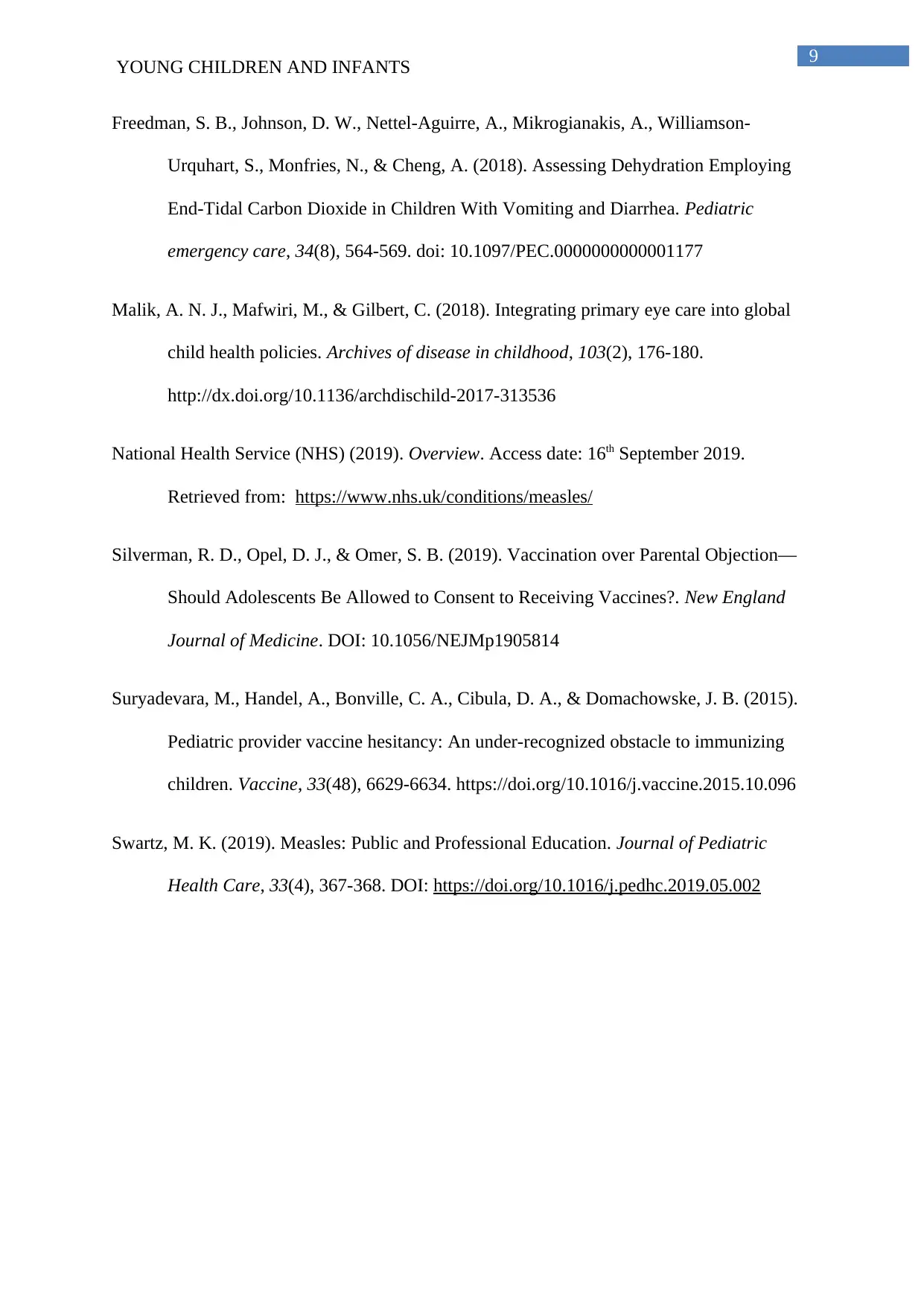
9
YOUNG CHILDREN AND INFANTS
Freedman, S. B., Johnson, D. W., Nettel-Aguirre, A., Mikrogianakis, A., Williamson-
Urquhart, S., Monfries, N., & Cheng, A. (2018). Assessing Dehydration Employing
End-Tidal Carbon Dioxide in Children With Vomiting and Diarrhea. Pediatric
emergency care, 34(8), 564-569. doi: 10.1097/PEC.0000000000001177
Malik, A. N. J., Mafwiri, M., & Gilbert, C. (2018). Integrating primary eye care into global
child health policies. Archives of disease in childhood, 103(2), 176-180.
http://dx.doi.org/10.1136/archdischild-2017-313536
National Health Service (NHS) (2019). Overview. Access date: 16th September 2019.
Retrieved from: https://www.nhs.uk/conditions/measles/
Silverman, R. D., Opel, D. J., & Omer, S. B. (2019). Vaccination over Parental Objection—
Should Adolescents Be Allowed to Consent to Receiving Vaccines?. New England
Journal of Medicine. DOI: 10.1056/NEJMp1905814
Suryadevara, M., Handel, A., Bonville, C. A., Cibula, D. A., & Domachowske, J. B. (2015).
Pediatric provider vaccine hesitancy: An under-recognized obstacle to immunizing
children. Vaccine, 33(48), 6629-6634. https://doi.org/10.1016/j.vaccine.2015.10.096
Swartz, M. K. (2019). Measles: Public and Professional Education. Journal of Pediatric
Health Care, 33(4), 367-368. DOI: https://doi.org/10.1016/j.pedhc.2019.05.002
YOUNG CHILDREN AND INFANTS
Freedman, S. B., Johnson, D. W., Nettel-Aguirre, A., Mikrogianakis, A., Williamson-
Urquhart, S., Monfries, N., & Cheng, A. (2018). Assessing Dehydration Employing
End-Tidal Carbon Dioxide in Children With Vomiting and Diarrhea. Pediatric
emergency care, 34(8), 564-569. doi: 10.1097/PEC.0000000000001177
Malik, A. N. J., Mafwiri, M., & Gilbert, C. (2018). Integrating primary eye care into global
child health policies. Archives of disease in childhood, 103(2), 176-180.
http://dx.doi.org/10.1136/archdischild-2017-313536
National Health Service (NHS) (2019). Overview. Access date: 16th September 2019.
Retrieved from: https://www.nhs.uk/conditions/measles/
Silverman, R. D., Opel, D. J., & Omer, S. B. (2019). Vaccination over Parental Objection—
Should Adolescents Be Allowed to Consent to Receiving Vaccines?. New England
Journal of Medicine. DOI: 10.1056/NEJMp1905814
Suryadevara, M., Handel, A., Bonville, C. A., Cibula, D. A., & Domachowske, J. B. (2015).
Pediatric provider vaccine hesitancy: An under-recognized obstacle to immunizing
children. Vaccine, 33(48), 6629-6634. https://doi.org/10.1016/j.vaccine.2015.10.096
Swartz, M. K. (2019). Measles: Public and Professional Education. Journal of Pediatric
Health Care, 33(4), 367-368. DOI: https://doi.org/10.1016/j.pedhc.2019.05.002
1 out of 10
Your All-in-One AI-Powered Toolkit for Academic Success.
+13062052269
info@desklib.com
Available 24*7 on WhatsApp / Email
![[object Object]](/_next/static/media/star-bottom.7253800d.svg)
Unlock your academic potential
Copyright © 2020–2025 A2Z Services. All Rights Reserved. Developed and managed by ZUCOL.
